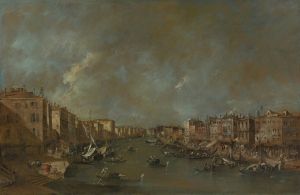
Newark, upon Trent
A hand-painted replica of Joseph Mallord William Turner’s masterpiece Newark, upon Trent, meticulously crafted by professional artists to capture the true essence of the original. Each piece is created with museum-quality canvas and rare mineral pigments, carefully painted by experienced artists with delicate brushstrokes and rich, layered colors to perfectly recreate the texture of the original artwork. Unlike machine-printed reproductions, this hand-painted version brings the painting to life, infused with the artist’s emotions and skill in every stroke. Whether for personal collection or home decoration, it instantly elevates the artistic atmosphere of any space.
Joseph Mallord William Turner, one of the most renowned British landscape painters, created the artwork "Newark, upon Trent" in the early 19th century. Turner, known for his expressive colorization, imaginative landscapes, and turbulent marine paintings, was a pivotal figure in the Romantic movement. His work often depicted the power and beauty of nature, capturing the sublime and the picturesque with a unique style that has influenced generations of artists.
"Newark, upon Trent" is a part of Turner's extensive collection of works that explore the British landscape. Newark-on-Trent, commonly referred to as Newark, is a market town in Nottinghamshire, England. The town is historically significant, with roots dating back to Roman times and a rich medieval history. It is known for its well-preserved castle, which played a role during the English Civil War, and its strategic location on the River Trent.
Turner's painting captures the essence of Newark's landscape, focusing on its natural beauty and historical architecture. His use of light and shadow, along with his characteristic brushwork, brings the scene to life, highlighting the interplay between the built environment and the natural world. The River Trent, a prominent feature in the painting, is depicted with Turner's typical attention to the movement and reflection of water, a recurring theme in his oeuvre.
The artwork reflects Turner's interest in the effects of light and atmosphere, as well as his fascination with historical sites. During his career, Turner traveled extensively across Britain, sketching and painting various locations. His travels provided him with a wealth of material, which he used to create both finished paintings and numerous sketches and studies. "Newark, upon Trent" likely originated from one of these journeys, where Turner would have observed the town and its surroundings firsthand.
Turner's technique in this painting, as in many of his works, involves a delicate balance between detail and abstraction. He often employed a loose, fluid style that allowed him to convey the mood and atmosphere of a scene rather than focusing solely on precise detail. This approach is evident in "Newark, upon Trent," where the overall impression of the landscape takes precedence over meticulous representation.
The painting is part of Turner's broader exploration of the British countryside, which he depicted with a sense of reverence and awe. His works from this period often reflect the Romantic ideal of nature as a powerful and sublime force, capable of evoking deep emotional responses. Turner's ability to capture the transient effects of light and weather further enhances the emotional impact of his landscapes.
"Newark, upon Trent" is a testament to Turner's skill as a landscape painter and his ability to convey the beauty and history of the British Isles. His work continues to be celebrated for its innovative use of color and light, as well as its ability to evoke the grandeur and majesty of the natural world. Turner's legacy endures, and his paintings remain a vital part of the canon of Western art, admired for their technical mastery and emotional depth.


















